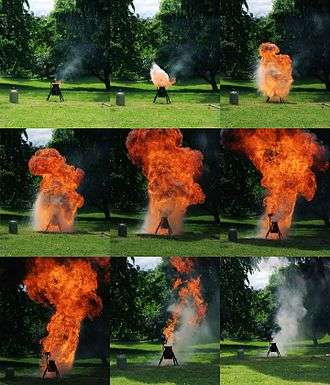Boilover

A boilover (or boil-over) type of fire refers to an extremely hazardous situation where an attempt is made to extinguish semi-enclosed oil or petrochemical fueled fire with water. The hazard results due to the difference in density between oil and water.
NFPA defines boil-over as: An event in the burning of certain oils in an open-top tank when, after a long period of quiescent burning, there is a sudden increase in fire intensity associated with expulsion of burning oil from the tank.[1]
Boilover is also common in the home as a chip pan fire when cooking.
As water is poured onto the fuel, it quickly sinks to the bottom of the container due to the water's higher density, and has little effect on extinguishing the flames on the surface. Under certain conditions, after some time, the water on the bottom rapidly vaporises into steam, causing it to expand more than 1700 times in volume. The rapidly expanding steam (possibly superheated) expels the oil or fuel above upward and out of the tank, resulting in the discharging of burning oil onto a large and uncontrolled area outside of the container.[2] Mathematical modelling of the phenomenon is difficult and complicated,[3] making boilover prediction unreliable.
 Oil gets so hot that it catches fire all by itself
Oil gets so hot that it catches fire all by itself Water is poured into the container
Water is poured into the container Water is denser than oil, so it sinks to the bottom. As the water touches the bottom, it is heated above its boiling point and instantly vaporizes.
Water is denser than oil, so it sinks to the bottom. As the water touches the bottom, it is heated above its boiling point and instantly vaporizes. The water vapour expands rapidly, ejecting the burning oil out of the container and into the air where its surface area increases hugely and combustion proceeds much faster, forming a fireball.
The water vapour expands rapidly, ejecting the burning oil out of the container and into the air where its surface area increases hugely and combustion proceeds much faster, forming a fireball.
 Oil is heated strongly
Oil is heated strongly After some time, it gets hot enough to catch fire
After some time, it gets hot enough to catch fire Pouring a very small amount of water into the fire ejects a plume of fire
Pouring a very small amount of water into the fire ejects a plume of fire With all the oil burned, there is no more fuel to supply the fire
With all the oil burned, there is no more fuel to supply the fire
See also
- Expansion ratio
- Fire Extinguisher Foams
- Phreatic eruption - a similar concept in volcanic eruption
- Wax fire
References
- ↑ National Fire Protection Association: "NFPA 30 - Flammable and Combustible Liquids Code"
- ↑ GARO, Jean-Pierre; Hiroshi KOSEKI; Jean-Pierre VANTELON (2007). "COMBUSTION OF LIQUID FUELS FLOATING ON WATER" (PDF). Thermal Science:. 11 (2): 119–140. doi:10.2298/TSCI0702119G. Retrieved 2008-11-09.
- ↑ Hristov, Jordan (2006). "An inverse Stefan problem relevant to boilover: Heat Balance Integral Solutions and Analysis" (PDF). Thermal Science. 11 (2): 141–160. doi:10.2298/TSCI0702141H. Archived from the original (PDF) on 2011-07-23.
External links
-
 Media related to Chip-pan fires at Wikimedia Commons
Media related to Chip-pan fires at Wikimedia Commons